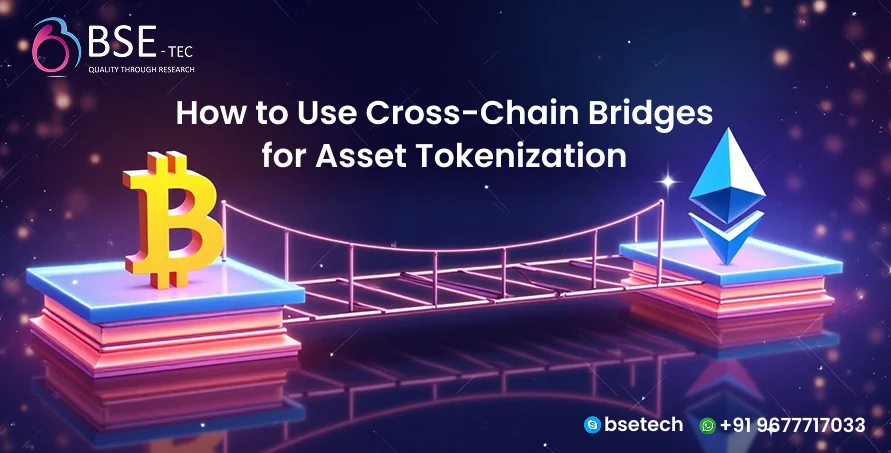
In the rapidly evolving world of blockchain technology, cross-chain bridges and asset tokenization are key innovations driving interoperability and asset management. Let us explore these concepts and how development companies are leveraging them.
What Are Cross-Chain Bridges?
Cross-chain bridges are protocols that enable the transfer of assets, data, or information between different blockchain networks. Since each blockchain operates independently with its own rules and token standards, bridges facilitate interoperability, allowing assets to move seamlessly across various chains. For example, transferring Bitcoin from the Bitcoin blockchain to Ethereum involves a cross-chain bridge, which locks the original asset on Bitcoin and issues a corresponding token on Ethereum.
What Is Asset Tokenization?
Asset tokenization involves converting physical or digital assets into digital tokens on a blockchain. These tokens represent real-world assets like real estate, art, commodities, or even financial instruments. Tokenization offers benefits such as fractional ownership, increased liquidity, transparency, and easier transferability. For instance, a real estate property can be tokenized into multiple shares, enabling investors worldwide to buy, sell, or trade fractions of the property.
How to Use Cross-Chain Bridges for Asset Tokenization?
Integrating cross-chain bridges into asset tokenization workflows unlocks several possibilities:
- Multichain Asset Availability: Developers can create tokenized assets that are accessible across multiple blockchains, expanding liquidity and user base.
- Enhanced Liquidity and Market Access: Using bridges, tokens representing assets can circulate on different platforms, increasing trading volume.
- Interoperable Systems: Assets can be moved freely between chains for various purposes, like staking, trading, or deploying on different decentralized applications.
- Facilitating Cross-Chain Settlements: Cross-chain bridges enable assets to serve as collateral or settlement tokens across different blockchain-based financial services.
Implementation Steps:
- Develop or adopt a reliable cross-chain bridge protocol (e.g., Wormhole, Multichain).
- Tokenize the asset on the initial blockchain, ensuring compliance with standards like ERC-20 or BEP-20.
- Lock or escrow the original asset on its native chain via smart contracts.
- Use the bridge to mint or release a corresponding token on the target chain.
- Enable users to transfer, trade, or stake the tokens across multiple chains as needed.
How are Development Companies Involved in Cross-Chain Asset Tokenization?
Blockchain development companies play a critical role in enabling cross-chain asset tokenization by:
- Creating Interoperability Solutions: Developing or customizing cross-chain bridge protocols tailored to client needs.
- Token Standards & Smart Contracts: Designing and deploying smart contracts that facilitate asset minting, locking, and burning across chains.
- Security Protocols: Ensuring secure bridge operations to prevent vulnerabilities like double-spending or asset theft.
- Regulatory Compliance: Handling legal and compliance aspects, ensuring tokenized assets adhere to jurisdictional rules.
- Consulting & Integration: Assisting clients in integrating cross-chain tools into broader DeFi, NFT, or traditional finance frameworks.
Real-World Examples of Cross-Chain Asset Tokenization
1. Real Estate Tokenization Platforms
- Example: A company tokenizes a property on Ethereum but wants to access liquidity or list it on other DeFi platforms on Binance Smart Chain (BSC). Using a cross-chain bridge, the property tokenized on Ethereum is locked in a smart contract, and a wrapped version (representing ownership) is minted on BSC.
- Benefit: Investors worldwide can buy fractions of the property on different chains, enhancing liquidity and investment flexibility.
2. NFT Cross-Chain Marketplaces
- Example: An art NFT created on Solana is bridged to Ethereum, allowing traders to buy or sell it across multiple NFT marketplaces supporting different chains.
- Benefit: Broader exposure and increased liquidity for digital assets, enabling artists and collectors to reach wider audiences. You can check with our NFT marketplace script, minttrades.
3. DeFi and Lending Platforms
- Example: A user can collateralize assets from different chains, like Bitcoin on the Bitcoin network or Binance Coin on BSC, by bridging them into a common DeFi ecosystem on Ethereum.
- Benefit: Diversifies collateral options, enhances liquidity, and creates seamless cross-chain financial services.
Industry Benefits from Cross-Chain Asset Tokenization
1. Real Estate
Tokenized real estate assets can be fractionalized and traded across multiple blockchains, increasing liquidity and accessibility for global investors.
2. Art & Collectibles (NFTs)
Cross-chain bridges let users trade NFT assets across multiple platforms, expanding market reach and boosting liquidity. Artists can sell their work on different marketplaces without being tied to one blockchain.
3. DeFi & Financial Markets
Decentralized finance platforms gain more interoperability, which lets users move assets across different protocols to optimize yields, collateralization, and liquidity.
4. Supply Chain & Commodities
Tokenizing physical commodities like gold or agricultural products and enabling cross-chain transfers facilitates global trading and more transparent, tamper-proof records.
5. Gaming Industry
Blockchain-based games tokenize game assets and in-game currencies, then bridge them across different platforms, allowing players to trade assets seamlessly across ecosystems.
Sum Up:
By bridging different blockchains, Blockchain development companies enable a more connected and liquid ecosystem for asset tokenization, opening up new avenues for investors and asset owners.
Cross-chain bridges for asset tokenization revolutionize asset management by enabling greater liquidity, accessibility, and interoperability. As blockchain technology advances, development firms like BSEtec – Blockchain development companies are vital in building secure, compliant, and innovative cross-chain solutions that empower the future of digital assets. For a deeper look at real-world solutions, explore our blog on cross-chain bridge protocols and how an asset tokenization development company can help you launch your blockchain project.
Did you find this article useful? Let us know by leaving a comment below, or join us on Twitter and Facebook.


